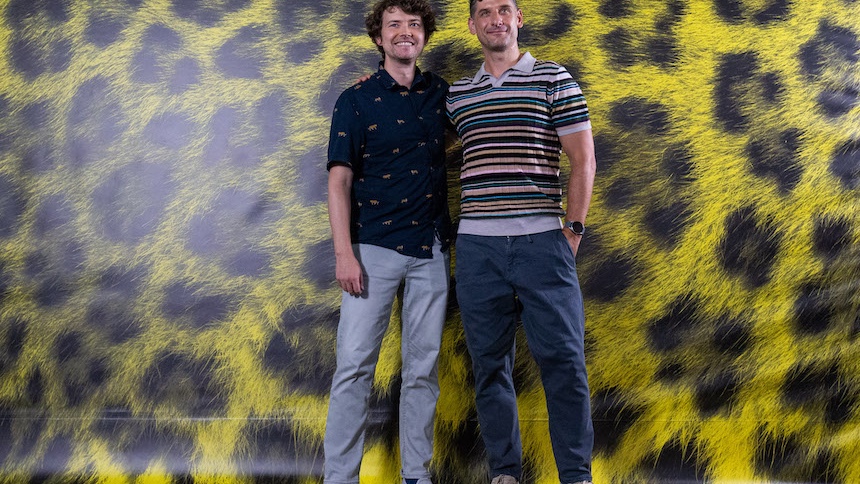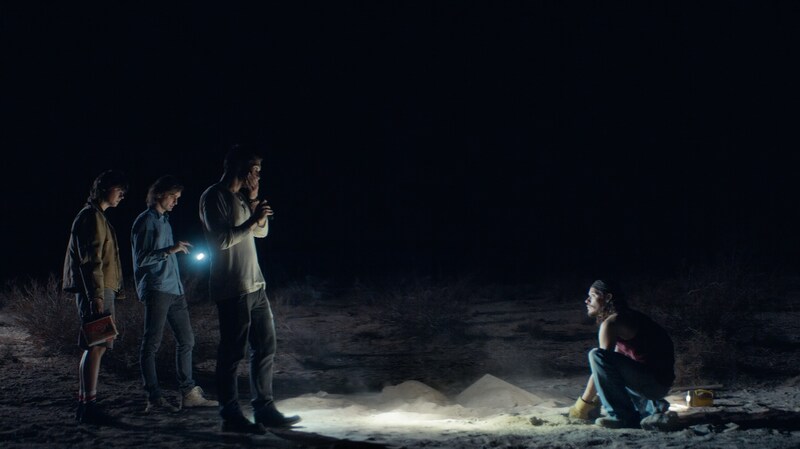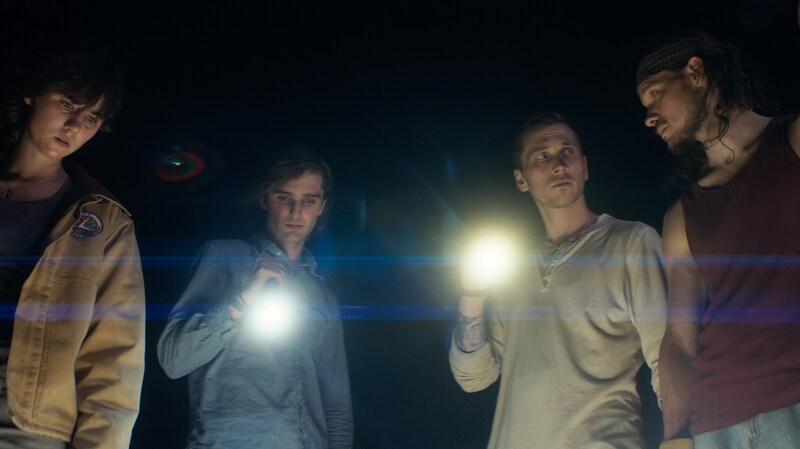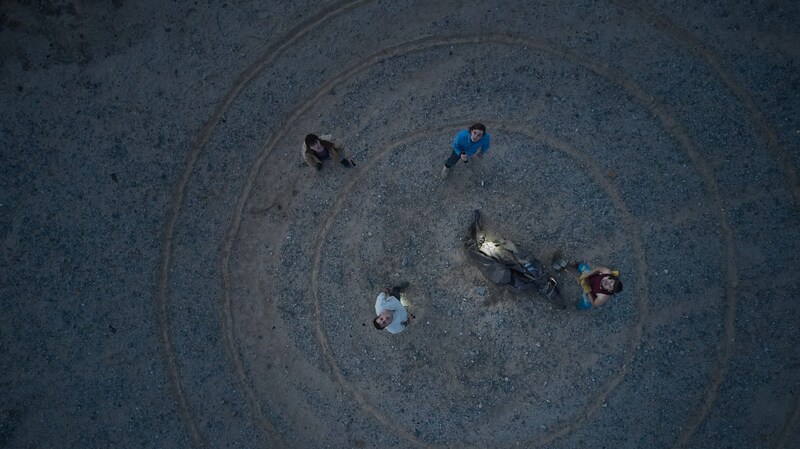FALLING STARS Interview: Richard Karpala and Gabriel Bienczycki on Indie U.S. Filmmaking

[Managing Editor's note: The film under discussion is a non-SAG, independent production, completed well before the SAG-AFTRA strike began earlier this year. Read more about the ongoing SAG-AFTRA strike.]
Screen Anarchy met with two emerging filmmakers, Richard Karpala and Gabriel Bienczycki, during the world premiere of their collaborative feature-length film Falling Stars at the Locarno Film Festival last month. Both filmmakers, who juggled several roles, walked us through the process, delights and tribulations of indie filmmaking in the U.S.
Falling Stars sees a trio of brothers in the Californian desert getting acquinted with witch folklore much closer than they would have prefered. The film is a coming-of-age road movie with implicit slasher tropes addressing the topic of brotherhood. [The interview has been lightly edited.]
Screen Anarchy: What was the genesis of the film?
Richard Karpala: It began with a dream I once had, and at first, I was uncertain about what to do with it. I thought, perhaps it could become a short story. This happened around the summer of 2021. Gabe and I had collaborated on a few projects by then, including a short film and a corporate endeavor. At the time, I was preparing to depart from LA and head to Prague, following my wife's graduation. I had this overwhelming feeling that if I didn't act on my idea before leaving, I would always regret it. So, I penned it down swiftly.
The concept had lingered in my mind for quite some time. Almost immediately after writing, I think either that day or the next, I shared it with Gabe for his thoughts. Our background as Polish-Americans plays a significant role in this story. We've been brought up hearing tales of witches and Baba Yaga.
When I began writing, I wasn't deeply invested in understanding all its nuances. I was genuinely exploring — exploring a sentiment that's been with me since childhood. The theme of brotherhood was introduced later. Being an only child until the age of 11, this story became a thrilling avenue for me to delve into the essence of brotherhood and understand its dynamics.
In the film, the bond between the characters isn't just harmonious; it's fraught with tension. It's not the typical 'kumbaya' relationship. Adam is eager to emulate Mike, who, on the other hand, yearns to break free from family ties and carve his own path. Then there's Sal, the middle brother, torn between these contrasting perspectives.
After my initial draft, I made a few revisions. Yet, the essence of the script was largely intact when I shared it with Gabe. Upon receiving it, did you, Gabe, make any edits?
Gabriel Bienczycki: As filmmakers, we're constantly on the lookout for intriguing projects. However, we're also grounded in the reality of what's achievable without delving into lengthy fundraising and trying to gain producers' interests to pitch a concept. Everyone has aspirations to craft an incredible film, but the process can often be protracted. It can sometimes take years to bring a vision to fruition.
What stood out about this project was its modest scale combined with its vast imaginative scope. This made it especially appealing. We embarked on it, knowing we could execute it with the resources and equipment we already possessed and the funds we could independently raise. We consciously avoided grandiose elements like exploding helicopters or massive crowd scenes. The charm lay in its minimalistic requirements, juxtaposed with the expansive world it introduced. Richard's concept quickly resonated with us, propelling us into pre-production. And within a few months, we were already filming.
Richard Karpala: Gabe and I have a knack for working swiftly on set. We didn't invest much time in storyboarding or extensive planning. When we arrived at the location with our actors, part of the excitement was in discovering how the scenes would come alive. Constraints often limited our rehearsal time, requiring us to think on our feet and improvise on the spot. In my view, this spontaneity is far more thrilling than over-preparing. Sticking too closely to a preconceived plan might rob us of those moments of genuine discovery or unscripted magic. And during our shoot, we experienced plenty of those spontaneous moments.
You are mixing two traditions in the film, European and American. How did that come about?
Richard Karpala:In the world we're envisioning, we delve into the influence of Puritanism from the past. When the Europeans first arrived, they introduced both positive and negative aspects to the New World. Notably, their intense Puritan beliefs suppressed the very witchcraft elements we're exploring in our narrative.
Fire is a central motif in our film, reflecting its significance in historical practices, especially in purging witchcraft. This emphasis on fire can also be traced back to Celtic traditions, where nature, particularly fire, marked transitional phases between seasons.
I genuinely strive to approach these subjects with earnestness. However, it's hard to ignore how the original essence has been eroded over the years, particularly by representations in mainstream media, such as Disney movies. Our aim is to revert to a more grounded perspective, a reference that I find particularly captivating. It's a portrayal I haven't frequently encountered in films, offering a fresh 'universe', so to speak, for creative exploration.
Gabriel Bienczycki: The narrative naturally evokes various societal commentaries. Given America's history with events like the witch burnings and prevailing superstitions, questions inevitably arise.
Are we commenting on current events, the divides between urban and rural dwellers, or the political polarities of Republican versus Democratic? While we didn't begin with such specific intentions, these themes emerged organically.
Richard, as he mentioned, was inspired by a dream. It's as if intuition led our storytelling. What's intriguing, especially by the film's end in the conversation with radio DJ Barry Foyle, is how the meticulously crafted world begins to show fractures, hinting at internal discrepancies and debates about its very nature.
In today's times, there seems to be a lack of agreement on pressing issues, like our planet's deteriorating condition. Despite these evident problems, consensus eludes us. While our film didn't initially aim to touch on these subjects, discussions surrounding it have highlighted these concerns. Many viewers sense a subtle undercurrent in the narrative. This lack of unanimity, in a way, adds a layer of realism to the story.
Richard Karpala: The film carries a political undertone, embodying a spirit of rebellion, even bordering on anarchy. We could have invested our resources, time, and money into other pursuits, but filmmaking is our passion. The story absorbs all these external influences. I'm not inclined to make definitive statements. I prefer a certain ambiguity, mirroring the complexities of the real world.
Gabriel, is it a political act?
Gabriel Bienczycki: Is this about filmmaking? Certainly. Richard crafts the story, meticulously building its universe. While the film brims with subtext and internal dialogue, at its heart, it's an evocative horror film that touches on brotherhood. We didn't intend for it to be a direct political commentary. It's primarily a suspenseful horror that delves into various dynamics, exploring themes of maturation and rites of passage.
There's been chatter about the film hinting at the changing times, especially given the current global warming crisis. Some see parallels, and I don't refute them. The narrative portrays brothers transitioning into a seemingly bleak future, referencing how harvest seasons are starting increasingly early.
Such subtleties might mirror our world's current challenges — political unrest, misinformation, extremism, and climatic changes — all alluding to impending difficulties. I appreciate this blend of poignant drama with the horror genre.
The drama and genre meshed intensively in the last several years. But still, you have older films like Roman Polanski's ROSEMARY'S BABY or KNIFE IN THE DARK that combined genre and drama back then. Did you also think around these lines when you were shooting FALLING STARS?
Richard Karpala: Knife in the Water is phenomenal. It's hard to fathom that it was his debut—such precision and control. Influences, I believe, emanate from myriad sources. Some influences spark a passion in you, compelling you to rise from your inertia and create. Perhaps a film so profound that it propels you from your seat, motivating you to act or affirming your capability to craft.
This drive gripped me in 2012 when I ventured into short films. A pivotal film for me was The House of the Devil by Ti West. Its blend of horror and drama was compelling, urging me to step out and craft my own narratives. However, my shorts always harbored a lighter tone. They never quite mirrored the grave intensity of The House of the Devil. I'm unsure if I can emulate such gravity, particularly the way West delves into subjects like the satanic panic. My stories usually intertwine humor and playfulness, likely a testament to influences from filmmakers like Joe Dante. What were your touch stones, Gabe?
Gabriel Bienczycki: As a cinematographer, my aim was to give our film a polished, professional look. There's always the risk with micro-budget indie films that they come off looking too economical, earning applause more for effort than execution. My goal was to elevate its appearance without a huge budget.
Films like Seven — with the collaborative genius of Darius Khondji and David Fincher — inspired me. I wanted to emulate their dark, composed, and tranquil filmmaking, full of visual suspense. By revealing less and hinting more, it's all about creating an atmosphere where what lurks in the shadows is more menacing.
Richard laid the narrative groundwork. My job was to visualize and adapt it to our capabilities. For me, the ensemble's performance was crucial. Hence, scene blocking and creating an environment conducive for our actors was vital. Much of our filming took place in a truck, requiring a variety of seating arrangements. The setups were somewhat reminiscent of the constraints in prison settings. There were instances when we squeezed nearly seven pages of script into just four hours of shooting.
Given the limitations you just mentioned, did you storyboard the scenes?
Gabriel Bienczycki: We opted not to use storyboards. They are often invaluable, especially for communicating with the DoP. But being the DoP and co-director myself, we streamlined our process. We did preproduction camera tests for specific sequences. Given that half of our film unfolds inside a car, and considering the limited angles once the car is lit, it didn't seem necessary to storyboard those moments.
Richard Karpala: I appreciate your insights on the truck scenes. Initially, we considered having total darkness outside. But soon, we realized it might give the impression that the truck was suspended in a void. Playing with rear projection gave the scenes a unique touch we loved. Experimenting was part of the journey.
For instance, Gabe, when you worked on making the rings in the desert glint subtly at night, we explored various methods to capture the ultraviolet spectrum. Though we had minimal techniques in our arsenal, it was fundamentally a lean production.
Gabriel Bienczycki: We didn't compromise on the quality of equipment. We utilized top-notch anamorphic lenses and filmed with the robust RED camera. The movie doesn't fall short in any aspect. The real challenge was lighting vast outdoor spaces with a limited crew and resources. Day or sunset shoots would have simplified things, but lighting a desert at night is a different ballgame.
You mentioned the ensemble performance of the cast. Did they have time to gel and create a chemistry?
Richard Karpala: Our casting director, Danny Dunnitz, was instrumental in helping us find our actors. Originally, we planned to cast the eldest brother, Mike, first, considering him the central figure of the story. However, during editing, Adam's presence became equally dominant, if not more so. Casting Adam became our initial focus, followed by Renee, then Andrew, and finally Shawn.
To build rapport among them, we even got them Dodgers' baseball tickets, capturing the essence of their last summer together before life changes. And about having a crying baby on set? I might rethink that in the future.
Gabriel Bienczycki: Our cast was diverse in experience. We had the privilege of casting Piotr Adamczyk, a superstar from Poland, in a cameo role. Many weren't aware of his acting prowess, so when he performed, it left many stunned. His commitment was evident when he'd simply drive to our desert location, change into his costume, and effortlessly become the desert mystic.
We also had newcomers for whom this was their first major project. Diane [Worman], in particular, caught our attention. Despite her recent foray into acting, she radiated the confidence and presence of a veteran.
And you both mentioned juggling, you know several responsibilities at the same time.
So I would be curious whether you have to be like really focused or whether there was a space to be intuitive.
Gabriel Bienczycki: We lacked an assistant director to oversee the schedule, so discipline was crucial. Balancing directorial duties while also handling the director of photography role meant juggling tasks like lighting setup, camera card formatting, and black shading.
With so much on our plates, Richard primarily took charge of cast performances. Absent a script supervisor, we occasionally overlooked scenes or lines and had to circle back. It truly was an all-hands-on-deck situation.
Richard's wife served as the set designer, while my girlfriend wore multiple hats as a makeup artist, a PA, and even managed food duties. Our crew was lean, with just six of us on set. When you watch the credits, you might wonder about the extensive list, but many contributed remotely. Despite the minimal physical presence, it was a collective effort.
How was it to run a film project production-wise?
Richard Karpala: The industry structure means that if you aim for a professional touch, the expenses can quickly skyrocket beyond an individual's budget. You'd really need a robust support system. That's just the stark reality we operate within.
So it's crucial for us to find creative ways to manage, either by relying on ourselves or collaborating closely with others, rather than solely depending on the established industry setup. This structure is more tailored for big-budget projects or productions like those for Netflix. It's a challenging aspect of the industry, but I'm hopeful for more support towards indie films.
Ideally, entities that back big-budget films would recognize the value in smaller, handcrafted projects and find ways to assist them. In our journey, we were fortunate. We received invaluable support from Works in Progress, part of the American Film Festival in Poland. Their grants for sound design and visual effects were instrumental in realizing our vision.
Such support mechanisms are indispensable for indie filmmakers; they're the boost that can take us over the finish line when resources are limited.
The film will screen at Fantastic Fest later this month and Celluloid Screams in October, among other festivals this fall.









